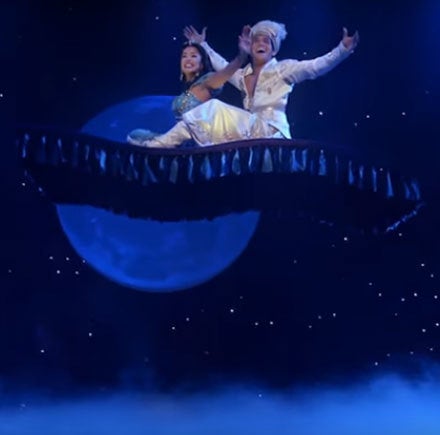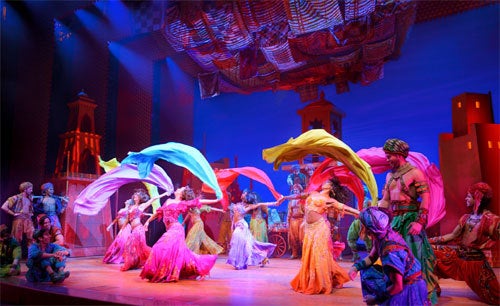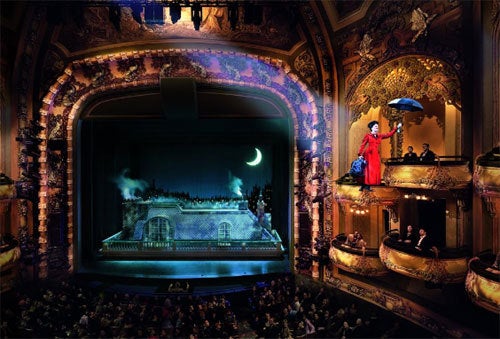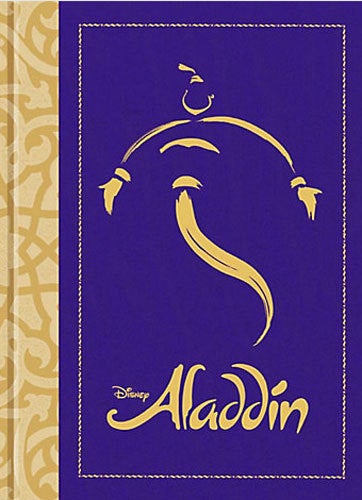There’s always a “How’d they do that?” moment in a Disney stage production. In “Beauty and the Beast,” it was when the performer playing the Beast first began spinning like a propeller and then transformed into a handsome prince right in front of the audience. For “Mary Poppins,” it was when that musical’s practically perfect title character first flew out over the orchestra section and then – umbrella & carpet bag in hand -- ascended towards the New Amsterdam’s balcony section.
And for Disney “Aladdin,” the hit Broadway musical, it’s when Jasmine joins Aladdin on that magic carpet. And – as “A Whole New World” plays – these two then soar off into a star-filled sky.

So how exactly is this illusion pulled off 8 times a week in both NYC & Chicago (Speaking of which: The North American tour of Disney “Aladdin” officially gets underway tonight as this Tony Award-winning show kicks off a 22 week-long stand at Chi-town’s Cadillac Palace Theatre)? Well, the folks at Disney Theatrical Productions are (understandably) kind of tight-mouthed when it comes to this topic. But if you pick up a copy of Michael Lassell’s terrific new behind-the-scenes book, “The Road to Broadway and Beyond — Disney Aladdin: A Whole New World” (Disney Edition, March 2017), you can uncover some clues.
Take – for example – what Bob Crowley (i.e., the seven time Tony Award-winner who handled “Aladdin” ‘s scenic design) has to say about this musical’s central showpiece. In his interview with Michael, Bob revealed that “ … the flying carpet is one of the biggest things in the show, and I had to accommodate that. When I saw the prototype, I was gob smacked … I was happy to work around it, but it did take up almost all of my mid-stage space. There were more than a few times when Casey (Nicholaw, the director & choreographer of “Aladdin”) or Tom (Schumacher, President of Disney Theatrical Group) would ask for something and I’d have to say, ‘I can’t give it to you because the carpet is up there.’ But it earns its keep and then some. It’s just fantastic, and to this day I have no idea how it works.”
Natasha Katz – who did the lighting design on Disney “Aladdin” – was similarly cagey when it came to this impressive piece of stagecraft. When she spoke with Lassell, Katz stated that “ … the magic carpet in this show is not very big, but the mechanism that makes it fly takes up a lot of technical real estate when it’s flying.”

Which is kind of ironic. Given that – when Disney Theatrical Productions mounted its pilot production of the stage version of “Aladdin” at Seattle’s 5th Avenue Theatre back in July of 2011 – that show’s magic carpet didn’t take up that all much real estate. Largely because – in this early, bare-bones edition of Disney “Aladdin” – that version of this illusion was basically (I’m quoting Casey Nicholaw now) just “ … a mattress on a stick.”
It wasn’t ‘til two years later (after Mouse House management finally agreed to fund a full-scale stage version of Disney “Aladdin”) that Schumacher then began to search for ways to make the flying carpet moment in his new Broadway-bound musical seem genuinely magical. Which is why Tom then reached out to the man who had masterminded the Beast’s onstage transformation as well as figuring out how to fly Mary Poppins out over the audience. And that was theatrical illusion designer Jim Steinmeyer.
As Schumacher recounted to Lassell in his interview for “The Road to Broadway and Beyond,” the inspiration of this particular piece of stagecraft can actually be traced back to Disney & Cameron Mackintosh's stage production of “Poppins.”

“One of the ways we talked about making Mary Poppins fly was a technique that dates back to the 1920s,” the producer said. ”But there had never been a technology that would make it work for our purposes. When we started working on ‘Aladdin,’ ten years after ‘Mary Poppins,’ I brought it up to him [Steinmeyer] again. Could it work? He said it could work in theory, but only if someone could actually deliver it.”
“After an elaborate search,” Thomas continued, ”We found these remarkable people at a place in Pennsylvania. The company is called TAIT Towers and they do a lot of rock ‘n’ roll shows for the top acts in music – everyone from Cher, Madonna, and Lady Gaga to Metallica, Justin Timberlake, and Elton John. They produce high-end equipment that theater people never use.”
“And we went and met with them, with Adam Davis and Scott Levine in particular, who were the project leads. And we drew little pictures of what the engineering concept was,” Schumacher recalled. “And they said, ‘Oh, we could do that.’ And I think we gave them five or six months and then we drove for hours out into rural Pennsylvania to their shop. And we walked in, and a wooden version of the carpet was flying around their scene shop in broad daylight, and I thought ‘Oh my goodness, this could work.’”

Cover of Michael Lassell’s “The Road to Broadway and Beyond — Disney Aladdin: A Whole New World.”
As Jim shared with Michael for “The Road to Broadway and Beyond,” the very best part of working on a high profile stage production like “Aladdin” is “ … today we can bring a number of optical illusionary effects together with new science and engineering to make something that pleases the audience. And a good part of the reason they’re pleased is that they can’t figure out how it could possibly be done, which has always been part of the joy of magic.”
“But that said, it’s also fun when an illusion takes on a life of its own, the way the carpet does in ‘Aladdin.’ And everyone (on this show’s creative team) seems to have understood its theatrical potential right from the beginning. Casey completely understood what he had, and he choreographed that carpet as if it were a character,” Steinmeyer continued. “We even gave the carpet a little curtain call of its own. We weren’t planning to bring it back for the end of the show, but sometimes things just work out.”
But – of course – because Michael Lassell’s “The Road to Broadway and Beyond — Disney Aladdin: A Whole New World” doesn’t reveal how the magic carpet illusion in this Tony Award-winning show is actually achieved … Well, that’s something you’re just going to have to work out on your own.

Because you can forget about asking members of the cast about how the magic carpet in “Aladdin” flies. They’ve all been sworn to secrecy about this exquisite piece of stagecraft as well as this show’s 83 other illusions & special effects.
As ensemble member Dennis Stowe told Lassell, “Everyone asks me how that magic carpet works. I just say it’s Disney magic.”
Cast member Bobby Pestka concluded, “I say the Genie does it.”
